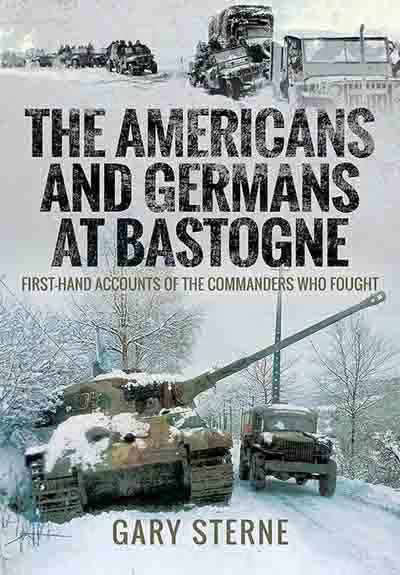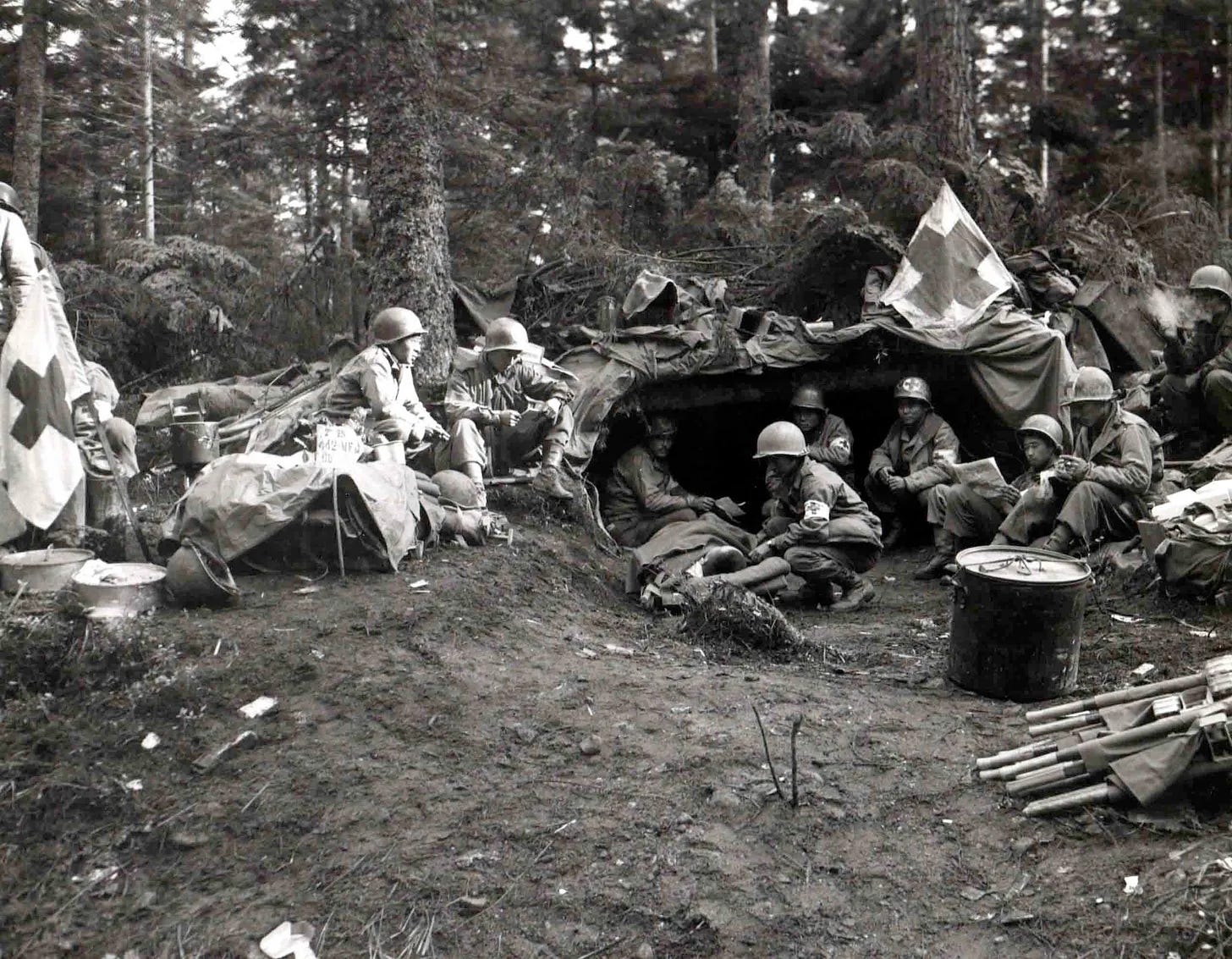The Americans and Germans at Bastogne
First-hand accounts of several German Generals on their preparedness for Hitler's Ardenne Offensive on 15th December 1944

Much has been written about the Battle of the Bulge - but new perspectives and original material continue to emerge. Gary Sterne’s research in the US Archives uncovered the original interrogations of German officers immediately after the war, conducted by the US Army Historical Division. He translated the original transcripts and focused on all the material concerning the Siege of Bastogne.
World War II Today is currently 50% off !
Subscribe now to follow the daily experience of war - and get full access to the over 1000 posts in the archives …
The views of the German officers had been incorporated into the general US military histories. However, the first-hand accounts of the German generals were not generally available until the publication of The Americans and Germans at Bastogne: First-Hand Accounts from the Commanders Who Fought in 2020. The following excerpt looks at the German situation on the 15th December 1944 and the early hours of the 16th:

Generalleutnant Fritz BAYERLEIN [Panzer Lehr Division]: The secrecy factors did not hinder the success of the offensive. All the preparations of the division, regiments and battalions moved smoothly. The troops were always prepared for anything (experienced, from their numerous unexpected commitments) and had just come from combat in the Saar. The commanders were all very well trained and ready for anything.
The following replacements were assigned to us up to 15 December:
a) 600 men, but almost all without weapons (more men came later, during the offensive), some 250 from convalescence.
b) 40 tanks and tank destroyers (later a further 15 tank destroyers).
Guns: 18 Guns (88mm, 105mm and 150mm) but almost all without prime movers - special weapons (mortars, machine guns and submachine guns).Only individual allocations. One whole battalion had no mortars and very few MGs. One tank battalion of the tank regiment was being reorganised in Fallingbostel and equipped with the ‘Sperber’ (night aiming) device.
[We were] 60 per cent of combat strength of troops; 40 per cent of tanks, and Tank Destroyer Battalions (1 battalion missing) 60 per cent of guns, 40 per cent of other weapons. In place of the missing tank battalion the division received: 539 Heavy TD Battalion (with Panther type TDs) 30 per cent equipped at the beginning of the attack; 243 Assault gun battalion, 70 per cent equipped. Smoke guns and heavy artillery were not supplied; these were controlled by Corps and used principally to support the first attack over the Our.
Generalmajor Heinz KOKOTT [26th Volksgrenadier Division]: During the evening hours of 15 December, the final troop movements took place. It was cold and dark. The narrow paths of the Eifel, some of which were covered with ice, were densely crowded with troops and vehicles which were moving forward to their positions of departure and their firing positions. In spite of efficient traffic control, traffic jams were unavoidable. Efforts were made to drown out the noise of the motors of the heavy prime-movers by artillery harassing fire.
After dark, the commanders informed the attack troops of the attack order. The troops accepted it with utmost seriousness. They were fully conscious of their decisive act. They were confident in their ability, their strength and the promise of strong air support as well as the effort by the war industries back home. Attitude and morale of the troops was good.

Generalleutnant Hermann PRIESS [1st SS Panzer Corps]: The morning (15 Dec) amounts of motor fuel were reserved for the attack; 3 fuel units (for 100 kms) with vehicles; 2 fuel units (for lOOkms) with the supplies; 5 fuel units (for 100 kms) altogether. At 0530 hours, the artillery opened its preparatory fire and the attack itself was at 0600 hours. At about 0730 hours word first arrived from all the divisions that the enemy outpost positions had been taken and the attack was making excellent progress.
On the afternoon of 15 December 1944, the Panzer Divisions had 0.4 and 0.6 Verbrauchsaetze (100km fuel units). On urgent requests to Genfm Model, who was at the Corps command post, the Corps received further supplies of motor fuel in the evening, so that on 16 December the Panzer Division had 1.2 and 1.3 Verbrauchsaetze. Thus, taking into consideration the difficulties of terrain and route, it was possible to reckon with a range of 60 to 70km
Food supply was available to the troops for seven days, apart from iron rations. The Corps had been told that supplies were assured. But, practically speaking, there was very little fuel and ammunition, either for heavy infantry weapons, or guns. Furthermore, supply and issue deposits were partly east of the Rhine. In view of the enemy air superiority and road conditions, this meant two to three days for delivery. With the issue of fuel promised, the Corps was not dependent on the capture of enemy gasoline depots. But when the armoured divisions found how little fuel they had to go into battle, the Corps did hope to come across some supplies of gasoline.
Movement from the rest areas to the areas of concentration was to be completed in a single night. Approach routes were about 80km and 100km respectively. Upon urgent request two nights were then allowed for this operation. For movement, concentration and munitioning, the artillery - which also included the Panzer Division artillery - had been allowed five nights. This operation was begun on 10 December under command of the army. Each emplaced artillery battalion had counted positions and bridge-sites for three battalions of the reinforcement artillery, as well as surveying and preparing them. Gun positions for the reinforcement artillery had been chosen near roads offering camouflage in order to avoid visible tracks.
A security line was established about 8kms behind the main line of battle, which could only be crossed - even by reconnaissance units - by means of special passes issued by the commanding general. Some of the light artillery was brought up to its gun positions by horse beyond the security line. The remainder - including the heavy artillery - which had to be drawn by tractors, was brought into position during the last two nights. Low-flying aircraft were used to cover the inevitable noise. Ammunition was partly brought forward by horse, and partly carried by hand over the last, short distance.
Dietrich (Commander Sixth Panzer Army), on the other hand, employed a heavy artillery concentration for approximately half an hour before his attack. Personally, I think this was a waste of ammunition.

Walter STAUDINGER - Generalleutnant of the Waffen SS
We had a preparatory fire for one-half hour before the attack, although there were pauses in the firing during this time due to the shortage of ammunition. In all, we planned the following three types of fire for the first day: (1) fire on the main line of resistance, starting about 0500 hours; (2) fire on the command posts, road crossings villages in the neighbourhood of the main line of resistance, and other standpoints, thus cutting (US) lines of communication; and (3) fire on the more distant villages and standpoints, and especially roads on which we thought reserves would be brought up.
I wanted to concentrate the artillery in firing positions to cover the Eisenberg Ridge, where I thought we would encounter the heaviest opposition; however, I was over-ruled and we distributed the artillery almost evenly along the entire Army front.
Only the light battalions of divisional artillery were to move forward with the tank columns. The Corps Artillery was to fire from its positions as long as it could. As many of the large calibre guns required special emplacements, Army Artillery was not to displace until the Meuse River had been reached. Actually, the self-propelled artillery with Pepper task force (1st SS Panzer Division Leibstandarte SS Adolf Hitler) didn’t get enough fuel and was recalled. Most of the Volksartillery battalions didn’t move forward because of the lack of fuel and also because of the clogged roads. General Model found two or three of these battalions in their original positions and ordered me to court-martial their commanders. When I told him it was because of the fuel shortages and road conditions that they hadn’t moved, he rescinded his order. We had sufficient gas for the attack, but it was just too far back. Our general policy was to capture gas and use it wherever possible.
© Gary Sterne 2020, 'The Americans and Germans at Bastogne: First-Hand Accounts from the Commanders Who Fought'. Reproduced courtesy of Pen & Sword Publishers Ltd.
Affiliate Links
Recently on World War II Today ...
A surgeon on the front line
It is constantly amazing the terrific tenacity to life that these boys manifest. It is impossible to exaggerate what wonderful patients American boys are. They are brave and patient, seldom complaining, always cooperative. They accept pain without moans.
They seldom become demanding of attention, no fussing for little things, nor claiming petty comforts as their due. They have complete trust and faith in their medical corps. They accept unhesitatingly and with confidence whatever their surgeon tells them must be done; and they are grateful.




